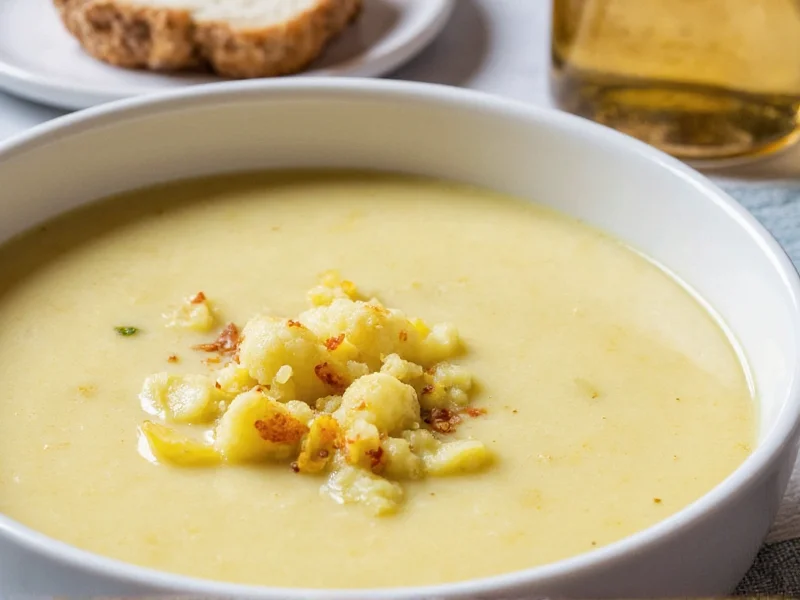Cauliflower potato soup has emerged as a kitchen staple for health-conscious home cooks seeking creamy comfort without excessive calories. This dynamic duo combines the natural starchiness of potatoes with cauliflower's ability to create velvety textures, resulting in a soup that satisfies without weighing you down. Unlike traditional cream-based soups that can exceed 300 calories per serving, this vegetable-powered alternative delivers rich flavor while staying within reasonable calorie boundaries.
The Nutritional Powerhouse Behind This Comfort Food
What makes cauliflower potato soup stand out nutritionally? Both vegetables bring impressive profiles to the pot. Potatoes provide potassium and vitamin C, while cauliflower contributes vitamin K, vitamin C, and glucosinolates with potential anti-inflammatory properties. When prepared without heavy cream, this soup becomes a nutrient-dense option that supports various dietary approaches including vegetarian, vegan, and gluten-free eating patterns.
Essential Ingredients for Perfect Cauliflower Potato Soup
The magic of creamy cauliflower potato soup recipe lies in ingredient quality and balance. You'll need:
- 1 medium head cauliflower, cut into florets
- 2 large Yukon Gold potatoes, peeled and cubed
- 1 large onion, diced
- 3 cloves garlic, minced
- 4 cups vegetable broth (low sodium preferred)
- 2 tablespoons olive oil or butter
- Salt and freshly ground black pepper to taste
- Optional: 1/2 cup unsweetened almond milk for extra creaminess
Yukon Gold potatoes work best for easy cauliflower potato soup for beginners because they break down more readily than russets, creating a naturally creamier texture without requiring as much blending.
Step-by-Step Preparation Guide
Creating the perfect healthy cauliflower and potato soup requires attention to cooking technique:
- Sauté aromatics: Heat olive oil in a large pot over medium heat. Add onions and cook until translucent (about 5 minutes), then add garlic and cook for 1 minute more.
- Add vegetables: Stir in potatoes and cauliflower florets, coating them with the aromatic base.
- Pour in broth: Add vegetable broth until vegetables are completely submerged.
- Simmer until tender: Bring to a boil, then reduce heat and simmer for 20-25 minutes, or until vegetables pierce easily with a fork.
- Blend to perfection: Using an immersion blender, puree the soup until smooth. For extra silkiness, pass through a fine-mesh sieve.
- Season and finish: Adjust salt and pepper, and stir in almond milk if using for additional creaminess.
Dietary Adaptations for Every Kitchen
One of the greatest strengths of cauliflower potato soup with garlic is its adaptability. Whether you're following specific dietary requirements or simply experimenting with flavors, these variations work beautifully:
| Dietary Need | Simple Adaptation | Flavor Enhancement Tip |
|---|---|---|
| Vegan | Use olive oil instead of butter, omit dairy | Add nutritional yeast for cheesy notes |
| Gluten-Free | Naturally gluten-free (verify broth) | Top with gluten-free croutons |
| Low-Sodium | Use homemade or low-sodium broth | Boost flavor with fresh herbs instead of salt |
| Keto-Friendly | Reduce potato quantity, increase cauliflower | Add bacon fat when sautéing onions |
Pro Tips for Soup Success
Mastering low calorie cauliflower potato soup requires attention to detail. These professional techniques elevate your results:
- Sweat, don't brown: Cook onions slowly over medium-low heat to develop sweetness without caramelization, which can overpower the delicate vegetable flavors.
- Uniform cutting: Ensure potato and cauliflower pieces are similar in size for even cooking.
- Temperature control: Never boil vigorously after adding dairy alternatives, as this can cause separation.
- Resting time: Let the soup sit for 15 minutes after blending to allow flavors to meld before serving.
Serving Suggestions That Impress
Transform your cauliflower potato soup for meal prep from simple to spectacular with these finishing touches:
- Drizzle with herb-infused olive oil
- Sprinkle with toasted pumpkin seeds for crunch
- Add a swirl of pesto for color contrast
- Garnish with fresh chives or microgreens
- Pair with a simple green salad and crusty bread
This soup's neutral flavor profile makes it exceptionally versatile for pairing. For a complete meal, serve with a side of roasted Brussels sprouts or a simple arugula salad with lemon vinaigrette.
Storage and Reheating Guidelines
Understanding proper cauliflower potato soup storage tips ensures quality across multiple servings:
- Refrigeration: Store in airtight containers for up to 4 days
- Freezing: Freeze without dairy additions for up to 3 months; add dairy when reheating
- Reheating: Warm gently over medium-low heat, stirring frequently
- Texture adjustment: Add splashes of broth when reheating to restore ideal consistency
When properly stored, this soup often tastes even better the second day as flavors continue to develop. For meal preppers, portion the soup into individual containers for convenient grab-and-go lunches throughout the week.
Troubleshooting Common Issues
Even the most experienced cooks encounter challenges with cauliflower potato soup variations. Here's how to address frequent problems:
- Grainy texture: This occurs when vegetables aren't fully cooked before blending. Solution: Simmer longer until extremely tender, or pass through a fine-mesh sieve after blending.
- Too thin: Create a slurry with 1 tablespoon cornstarch and 2 tablespoons cold water, then whisk into simmering soup.
- Too thick: Gradually add warm broth or water until desired consistency is reached.
- Bland flavor: Boost with acid (lemon juice or apple cider vinegar) or umami elements (miso paste or nutritional yeast).











 浙公网安备
33010002000092号
浙公网安备
33010002000092号 浙B2-20120091-4
浙B2-20120091-4